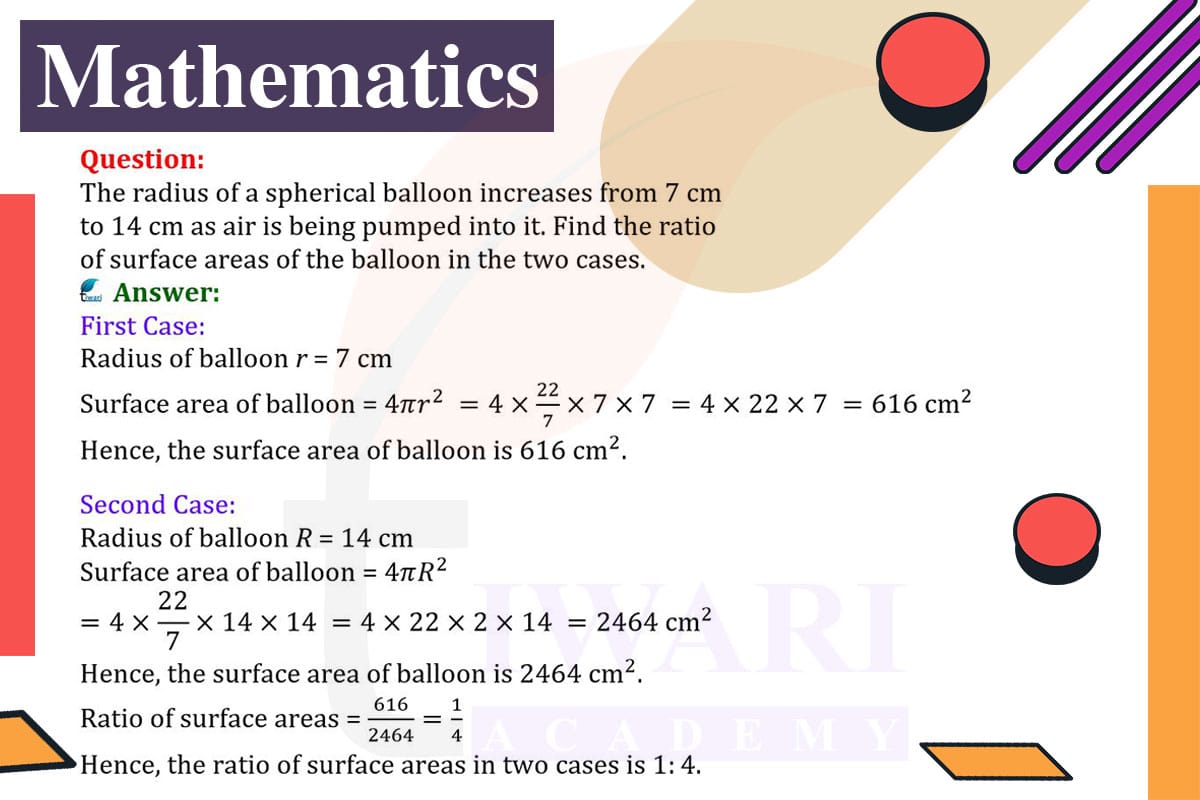To find the ratio of surface areas of a spherical balloon as its radius increases from 7 cm to 14 cm, we use the formula for the surface area of a sphere, 4πr².
For the initial radius of 7 cm, the surface area is 4 × 3.14 × 7² = 615.44 cm².
For the increased radius of 14 cm, the surface area is 4 × 3.14 × 14² = 2461.76 cm².
The ratio of the surface areas is 2461.76:615.44, which simplifies to 4:1. This demonstrates that the surface area increases by a factor of four when the radius is doubled.

Let’s discuss in detail
Surface Area Ratio in Spherical Balloons
The problem at hand involves understanding how the surface area of a spherical balloon changes as its radius increases. Specifically, we examine a balloon whose radius expands from 7 cm to 14 cm. The concept of surface area is crucial in various fields, including physics and engineering, particularly in understanding properties like pressure and volume in relation to size. To find the ratio of the surface areas in the two cases, we apply the formula for the surface area of a sphere, which is directly proportional to the square of its radius.
Initial Surface Area Calculation
Initially, the balloon has a radius of 7 cm. The surface area of a sphere is given by the formula 4πr². Substituting the initial radius into this formula, we calculate the initial surface area as 4 × 3.14 × 7². This calculation yields 615.44 cm². This initial surface area is crucial as the baseline for understanding how the surface area changes as the balloon expands.
Expanded Surface Area Calculation
When the balloon’s radius increases to 14 cm, we again use the surface area formula 4πr². Substituting the new radius, the calculation becomes 4 × 3.14 × 14², resulting in a surface area of 2461.76 cm². This expanded surface area is significantly larger than the initial area, reflecting the increased size of the balloon.
Understanding the Ratio of Surface Areas
To find the ratio of the surface areas, we compare the initial and expanded surface areas. The ratio is calculated by dividing the expanded surface area by the initial surface area. The ratio of two surfaces is 4:1.
Definition of Surface Area
Surface area refers to the total area that the surface of a three-dimensional object occupies. It is a measure of the extent of a two-dimensional surface covering the outside of an object. For various shapes, such as cubes, spheres, cylinders, and complex structures, the surface area can be calculated using specific mathematical formulas. This concept is crucial in both geometry and real-world applications. In geometry, surface area is used to understand and calculate the properties of different shapes. In practical terms, knowing the surface area is essential for tasks like determining the amount of paint needed to cover an object, the amount of skin covering an organism, or the amount of fabric required to cover a shape.
Importance and Applications of Surface Area
The concept of surface area is not only fundamental in mathematics but also has significant applications in various fields. In engineering and architecture, surface area calculations are vital for designing objects and structures, ensuring that materials are used efficiently. In science, particularly in chemistry and physics, surface area plays a crucial role in phenomena like the rate of chemical reactions, as a larger surface area can lead to faster reactions. In biology, the surface area of organisms affects heat loss and nutrient absorption. Thus, surface area is a key concept that bridges theoretical mathematics with practical, real-world problems and phenomena.
Discuss this question in detail or visit to Class 9 Maths Chapter 11 for all questions.
Questions of 9th Maths Exercise 11.2 in Detail


